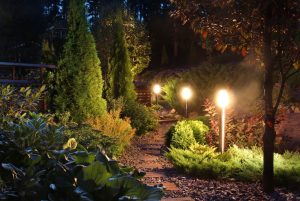Your home is your biggest investment and a source of pride. You’ve done a lot to improve your home’s curb appeal—nice lawn, appealing landscaping and beautiful color in your flower beds year-round. Exterior landscape lighting can make your home stand out. The warm glow of soft light shining on your home in the evening is truly enhancing and a fantastic way to add value to your residential property.
 Many benefits come with the installation of professional low voltage landscape lighting. One is that outdoor lighting improves the safety and security of your home by illuminating dark areas of your yard and property. It cuts down on trips and falls and makes it easier to see intruders who shouldn’t be on your property in the first place.
Many benefits come with the installation of professional low voltage landscape lighting. One is that outdoor lighting improves the safety and security of your home by illuminating dark areas of your yard and property. It cuts down on trips and falls and makes it easier to see intruders who shouldn’t be on your property in the first place.
Outdoor lighting is beautiful. It definitely can give your property a facelift. Outdoor lighting might even transform wasted, dark space into something that is illuminated and usable, like a patio area, grilling space or fire pit area. Perhaps one of the best advantages is that modern outdoor lighting is very low voltage and therefore very energy efficient.
Low Voltage Lighting Options
Low voltage halogen or LED lights are available on the market today. Retailers offer a wide selection of fixtures and bulbs. These lights only use 12 volts of electricity, compared to the standard 120 volts in a regular electrical line in your home. These outdoor lines are much more energy efficient and very easy to install. One of the big pains of the old lighting systems was bulb changing, but that problem has been solved with the modern systems.
A 20W halogen bulb can last up to 5,000 hours or about three years, while an LED 5W bulb can last ten times that span—50,000 hours or 30 years. They last longer because they use a minimal amount of electricity, so they don’t have the constant surges of power that traditional bulbs have. LED lights can be purchased as a hardwired option or as a solar option, but the solar option is not as bright as the hardwired version. Both LED and halogen lighting systems have come down in price dramatically over the last few years. The hardwired options use a power converter to convert the 120V supply to 12V for the lighting.
LED lights certainly last longer than traditional bulbs or even halogen bulbs, but they can decline in performance if the specialized bulb coating begins to wear off. This will alter the brightness as well as the color of light. If you notice that your light is changing from a soft yellow to more of a blue light, this likely means the coating is degrading.
Types of Lighting
There are many options for outdoor lighting these days. You can illuminate pretty much whatever you want to illuminate—tree uplights, path lights, deck lighting, and floodlights.
Pathway lights are frequently used by homeowners to light sidewalks, pathways, walkways and long flower beds. Uplights can be used to provide a feature light for certain anchor plants or trees that you want to show off, or these lights can be used to highlight a fountain or other architectural feature in your yard. These are low profile lights that sit at ground level or that are slightly buried so that the fixture doesn’t show.
Floodlights and spotlights can be mounted high in trees to shine down into the yard to accent the tree itself or a patio, deck, gazebo or fire pit area.
If you have an outdoor deck space, deck lighting is very popular. Lights can be affixed to deck rails, posts or stairs to illuminate different areas to achieve different effects.
Easy Installation
Low voltage lighting systems are easy to install. You can position them however you like, and most people dig a small trench to hide the wires by covering them with soil. If you ever want to move a light, you just pull it up and rebury the wire. A professional landscaper can safely install these outdoor lights.
Energy Efficient
Low voltage options use only 20 percent of the energy that a regular incandescent bulb uses, so they’re incredibly energy efficient. You’ll save money on your electric bill. And because they’re low voltage, the lights emit minimal heat. So they won’t damage heat-sensitive plants, and they’re safe and cool to the touch.
Lighting Ideas
Front porch: a well-illuminated front entrance is inviting to guests but also a deterrent to unwanted visitors. Many homeowners install lanterns on either side of the door or a large hanging light in a tall entryway.
Garage lighting: You can install beautiful lanterns on either side of your garage, or recessed lighting under a garage overhang. Motion sensor lights are a great idea and will turn on if there is movement in your driveway.
Steps, paths, and driveways: Illuminate these areas for safe walking and beautiful ambiance. Path lights can be installed at ground level to spread light across the walkway.
Decks and patios: Lighting can transform these areas into an outdoor escape that everyone will love.
Pools: If you have to landscape around your pool, consider ground level lighting and uplighting to highlight these areas.
Thank you for reading our blog! How can we help you? Contact us today.
